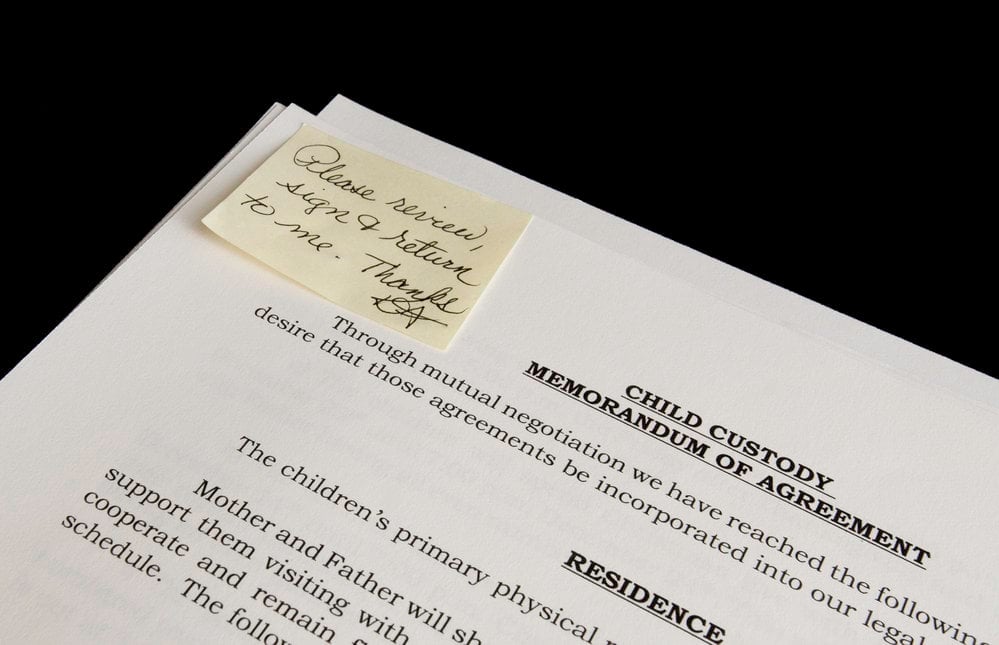Determining child custody can be a complicated and emotionally-charged issue for parents who are separated or going through a divorce. Without a court order, understanding who has custody rights over a child may seem unclear. This article will address the primary factors influencing custody decisions and guidance on establishing a fair and beneficial arrangement for the child.
Parents generally have equal rights and responsibilities to their children when no court order has been established for child custody. This means that decisions about education, healthcare, and other aspects of the child’s life should be made jointly. However, complications may arise when parents cannot reach a consensus on these matters or when one parent has predominantly provided care and support for the child.
To avoid potential disputes and to prioritize the best interests of the child, it is crucial for parents to communicate openly and to consider establishing a formal custody arrangement. While court intervention may sometimes be necessary, many parents resolve custody matters through mediation, parenting agreements, or other less adversarial methods.
Understanding Child Custody Without a Court Order

Legal Custody
Parents usually maintain equal rights and responsibilities towards their children in cases without a court order for child custody. This is because the law generally assumes that the parents will make joint decisions in the child’s best interest. In this scenario, both parents have legal custody, which means they have the authority to make crucial decisions about the child’s upbringing, education, healthcare, and religion.
However, this dynamic can become more complex if one parent is absent or involved in the child’s life. The other parent then naturally takes on full decision-making responsibilities.
Physical Custody
Physical custody refers to the parent with whom the child lives. Without a court order, there is no official determination of which parent has primary physical custody. In most cases, the child lives with one parent while the other has visitation rights. The parents may have an informal agreement defining their physical custody arrangement, which can be flexible and adjusted.
If a dispute arises, parents may seek mediation, negotiation, or ultimately pursue a formal court order to address their concerns and establish sole or joint custody arrangements. Parents should prioritize the child’s best interests when determining physical custody arrangements, stability, proximity to school or extracurricular activities, and other influential aspects of the child’s life.
In summary, without a court order, parents generally share equal rights and responsibilities regarding legal custody. In contrast, physical custody arrangements are left up to the parents to agree upon. However, if disputes arise, it may be necessary to seek a court order to ensure the child’s best interests are protected.
Custody for Different Parental Situations
Married Parents
In the case of married parents living together, both parents automatically share legal custody of the child. This means they have equal rights to decide about the child’s healthcare, education, and upbringing. Typically, no legal documentation is required since the custody is assumed to be shared.
If married parents separate but do not yet have a court order, both parents are still considered to have legal custody. However, it is recommended that they work out a temporary agreement to avoid confusion and miscommunication regarding the child’s care.
Divorced Parents
For divorced parents, custody arrangements are determined during the divorce process. This may include physical custody (where the child lives) and legal custody (decision-making power). These arrangements can be either:
- Joint custody: Both parents share equal responsibility and decision-making power.
- Sole custody: Only one parent has primary custody and decision-making power.
If there is no court order, the divorced parents need to establish a custody arrangement, either through an informal agreement or by seeking legal assistance.
Unmarried Parents
When parents are unmarried, custody can be more complex. In many places, the mother automatically has sole legal and physical custody of the child when no court order exists, regardless of whether the father’s name is on the birth certificate. Father does have the same rights but must establish paternity first, so there is an extra step, especially if the mother contests it.
If unmarried parents wish to establish a more formal custody arrangement, they should consider the following steps:
- Establishing paternity: If the father’s name is not on the birth certificate, he may need to prove that he is the child’s biological father through a paternity test.
- Creating a parenting plan: Parents can work together to create a written agreement outlining each parent’s rights and responsibilities, including visitation schedules and decision-making power.
- Seeking a court order: If the parents cannot agree on a plan, they may need to petition the court to establish a legally binding custody arrangement.
In all cases, parents should aim to create a stable, supportive environment for their child and prioritize their child’s well-being when considering custody arrangements.
Determining Paternity and Rights to Custody
Equal Rights
In general, the mother and father have equal rights to the child when no court order determines custody. This means that each parent has the right to decide for the child, and neither parent can deny the other access to the child. However, there are some instances where equal rights may not apply, such as when one parent has a history of violence, abuse, or neglect.
Establishing Paternity
Establishing paternity is essential for fathers to enforce their rights to custody. Several methods can be used to determine paternity:
- Voluntary Acknowledgement: When both parents agree, they can sign a voluntary acknowledgment of paternity form. This document legally establishes the father’s rights and responsibilities for the child.
- Presumed Paternity: If the couple is married at the time of the child’s birth, the husband is usually presumed to be the father. In some cases, this presumption can be challenged through legal actions, such as a paternity petition.
- Genetic Testing: When paternity is contested, a genetic test can be ordered by the court or sought by the parties involved. The test can provide conclusive evidence of the biological relationship between the father and the child.
Once paternity is established, the father can assert his rights to custody and visitation. If both parents cannot agree on a parenting plan, they may turn to the court to decide on custody arrangements. The court will consider the child’s best interests when making custody decisions, which may involve evaluating the parent’s ability to provide a stable home, the child’s relationship with each parent, and any history of abuse.
In cases with no court orders, parents must establish paternity and be aware of their rights to ensure the best outcome for their child.
Types of Child Custody Arrangements
Joint Legal Custody
Joint legal custody is a cooperative arrangement where both parents share their child’s decision-making rights and responsibilities. In such cases, parents work together on major issues affecting their children, such as education, medical care, and religious upbringing. However, day-to-day decisions may still be made independently by the parent with whom the child resides.
Joint Physical Custody
Joint physical custody involves both parents sharing physical custody of the child, allowing the child to spend an equal or near-equal amount of time living with each parent. However, this arrangement can vary greatly, with some families opting for a week-to-week schedule while others may choose a more flexible, alternating schedule. Therefore, parents need to create a detailed parenting plan that outlines the child’s living arrangements and addresses potential issues that could arise.
Sole Legal Custody
Sole legal custody grants one parent the right to make important decisions about the child’s well-being. The non-custodial parent may still have visitation rights but does not have any input on significant decisions. Examples of such decisions include educational choices, medical treatments, and the child’s religious upbringing.
Sole Physical Custody
Sole physical custody means the child lives primarily with one parent while the other is granted visitation rights. The visitation schedule can be flexible, set by the court, or created by the parents if they can work together. In this arrangement, the parent with physical custody typically has sole legal custody.
In summary, child custody arrangements can be categorized into four main types: joint legal custody, joint physical custody, sole legal custody, and sole physical custody. These arrangements serve as a general framework to guide parents when determining custody outcomes that best suit their families’ unique circumstances.
Creating a Parenting Plan
Schedule and Responsibilities
When creating a parenting plan, it’s essential to establish a clear schedule that outlines the time each parent will spend with their child. This can help avoid confusion and ensure a smooth transition for the child. When discussing a child custody arrangement, design the child custody schedules by age of the children impacted by any changes in routine. Breastfeeding infants, for example, may require a different schedule compared to young toddlers, who tend to be sensitive to body language and subtle signs of anxiety between caregivers.
Consider the following factors when creating a schedule:
- School and extracurricular activities
- Holidays and special occasions
- Work schedules of both parents
- Travel time between households
It’s also essential to delineate each parent’s responsibilities regarding the child’s daily care, such as:
| Parent | Responsibility |
|---|---|
| Parent 1 | Morning routine and school drop-off |
| Parent 2 | After-school activities and homework |
Additionally, both parents should make decisions regarding major life events, such as medical treatments, education, and religious upbringing.
Parenting Time and Visitation Rights
To ensure that both parents have adequate time with their children, their parenting plan should include specific details regarding visitation rights. When establishing these rights, consider the following:
- Frequency of visits: Determine how often each parent will have the child, whether every week or a specific number of days per month.
- Duration of visits: Specify the length of each visit, such as a weekend, a full week, or an extended period during school breaks.
- Location of visits: Indicate where each visit will occur, whether at the non-custodial parent’s home or a neutral location, like a park or community center.
- Drop-off and pickup arrangements: Clarify the transportation logistics, ensuring both parents know who is responsible for dropping off and picking up the child.
By addressing these aspects in a parenting plan, parents can help create a stable environment for their children while maintaining open lines of communication and cooperation.
What to Do in Cases of Abuse or Neglect
Handling child abuse or neglect can be extremely challenging when parents have not established a formal custody arrangement through the courts.
Signs to Look Out For
In cases of abuse, it’s crucial to stay vigilant for any possible signs. Some of the indicators to watch for include:
- Unexplained bruises, burns, or fractures
- Fearfulness or anxiety
- Avoidance of specific people or places
- Changes in eating, sleeping, or behavior patterns
For neglect, key signs to be aware of are:
- Lack of adequate clothing or hygiene
- Consistently missing school or other activities
- Unsuitable living conditions or lack of supervision
- Failure to provide medical or emotional care when needed
Taking Action
If you suspect a child is suffering from abuse or neglect, take the following actions:
- Report your concerns: Contact your local child welfare agency or call the police if the child is in immediate danger. Detailed information is crucial to help the authorities understand the situation and protect the child.
- Gather evidence: Document any visible signs of abuse or neglect, such as photos of injuries or the child’s living conditions. Keep a log of all incidents, including dates, times, and details of what occurred.
- Offer support: Be available to listen and support the child emotionally. Encourage them to share their feelings and concerns and assure them they are not at fault.
Acting on suspicions of abuse or neglect is crucial for safeguarding the child’s well-being. Your intervention can make a vital difference in their life.
Seeking Legal Help
When to Consult an Attorney
Consulting an attorney when navigating child custody matters without a court order is crucial. An experienced child custody lawyer can provide valuable guidance and help protect the child’s interests. Situations where legal help is highly recommended include:
- If there are concerns about the other parent’s fitness or commitment to their child’s well-being.
- The parents cannot agree on the terms of custody, resulting in potential conflicts.
- If there is a history of domestic violence, abuse, or any other unsafe environment for the child.
- When one parent is planning to move a considerable distance away, which may disrupt the child’s life.
Choosing a Child Custody Lawyer
Finding the right child custody lawyer can make a significant difference in achieving a favorable outcome. Here are some key factors to consider when looking for the right attorney:
- Experience and Specialization: Choose a lawyer who specializes in family law and has extensive experience handling child custody cases. This ensures they are well-versed in the nuances of child custody proceedings.
- Reputation: Look for a lawyer with a good reputation within your local legal community. You can seek referrals from friends and family or research online for a well-regarded attorney.
- Compatibility: Ensure the attorney you choose is easy to communicate with and shares similar values in terms of custody arrangements. Having a good rapport with your lawyer is essential to navigating the legal process successfully.
- Cost: Discuss fees upfront to ensure you can afford the legal services. Different attorneys have varying fee structures. It’s essential to find one that fits your budget without compromising quality.
Consulting with an attorney and choosing a child custody lawyer fit your needs is crucial in navigating child custody cases without a court order. They can provide guidance, expertise, and support, significantly assisting you in achieving the best possible outcome.
Possible Outcomes in Child Custody Cases
Court-Ordered Custody Arrangements
When there is no existing court order, parties involved in a custody case have several options. Courts may choose to make decisions about physical and legal custody based on the child’s best interests. In some cases, joint custody is awarded to both parents; this can be joint physical, legal, or both. To determine the ideal custody arrangement, courts often consider the following:
- The parent’s ability to care for the child
- The stability of each parent’s home environment
- The child’s relationships with both parents
- The child’s wishes, if appropriate
Settlement and Custody Orders
In some situations, parents may wish to avoid court and engage in a settlement process to establish a custody arrangement. In these cases, parents may negotiate a parenting plan outlining custody and visitation schedules, decision-making responsibilities, and other pertinent information. Parents can then present this plan to a judge for approval, resulting in a custody order. It is essential to take this step, as it solidifies the arrangement and makes it legally enforceable.
When parents cannot agree on custody, they might turn to mediation, where a neutral third party helps facilitate communication and guide both parties toward an agreement. If an agreement is reached in mediation, the parents can submit the parenting plan for a judge’s approval, obtaining a custody order.
Lastly, if parents cannot reach an agreement through negotiation or mediation, they must enter court. The court will gather all relevant information and decide based on the child’s best interests. The result will be a court-ordered custody arrangement that is enforceable by law.
Other Considerations
Child Support
In cases where there is no court order, the issue of child support may still arise. It is important to remember that both parents are financially responsible for supporting their child. In general, the non-custodial parent is often responsible for providing monetary assistance to the custodial parent to help cover the child’s expenses. This can include, but is not limited to:
- Housing
- Food
- Clothing
- Education
- Medical care
Moving Out of State
When a parent wishes to move out of state, it can create complications surrounding custody, especially when no formal court order is in place. If the move might impact the child’s best interests or access to the other parent, both parties need to agree. In cases where an agreement cannot be reached, it might be necessary to seek legal assistance to resolve the matter.
Siblings
Siblings can play a critical role in a child’s life, and their relationships should generally be considered when determining custody arrangements. Without a court order, parents should strive to maintain stability and continuity in the child’s relationships with their siblings, if possible. This may involve joint custody arrangements, visitation schedules, or other accommodations that promote healthy sibling relationships.
Supervised Visitation
In certain situations, it may be necessary to implement supervised visitation to ensure the child’s safety and well-being during their time with the non-custodial parent. These may include instances where there are concerns about the parent’s mental health, substance abuse, or any history of domestic violence. In addition, supervised visitation can help provide a secure and controlled environment for maintaining parent-child relationships while addressing potential risk factors.




